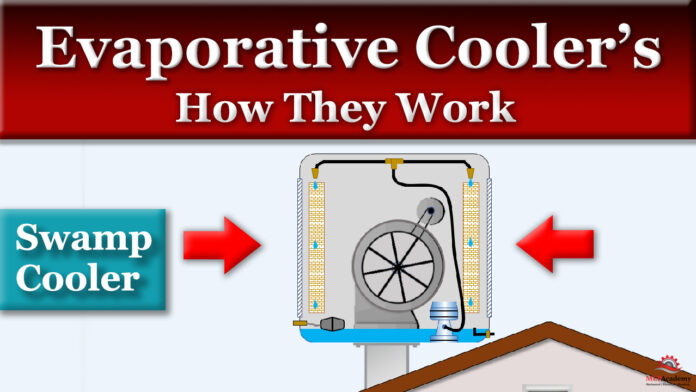How do Evaporative Coolers Work? Areas with low-humidity levels can benefit from evaporating water into the air supplied for space cooling, whether residential or commercial. There are two basic types of evaporative coolers, indirect and direct evaporative coolers. We’ll be covering direct evaporative coolers, often called swamp coolers, which means that the water used for cooling comes in direct contact with the air stream.
We’ll show you how they work and how they are installed. We’ll also learn how to size an evaporative cooler based on climate zones, along with air flow strategies and how they’re ducted.
If you prefer to watch the Video of this presentation, then scroll to the bottom or click on the following link “How do Evaporative Coolers Work“.
Evaporative cooling involves passing dry outdoor air over water saturated pads which causes the water to evaporate and cool the air delivered to the space.
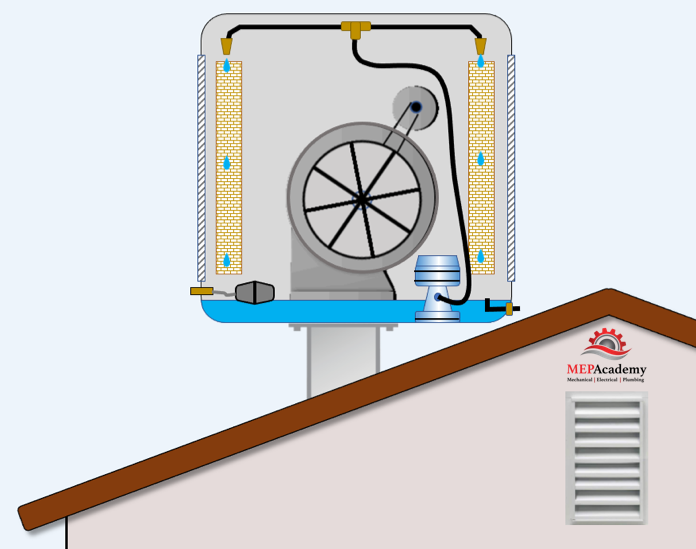
Construction of an Evaporative Cooler
The evaporative cooler is housed in a sheet metal box. Inside the box there is a fan that blows air into the space, and a water reservoir where a recirculating water pump will sit. Then there is tubing from the pump to spray heads above media pads on the air intake sides of the cooler. There is a float valve and float to maintain water in the reservoir, while an overflow drain is provided for excess water drainage.
There are several options on where to install the evaporative cooler. It can be installed on the roof, a wall or on the ground.
Checkout these Evaporative Coolers here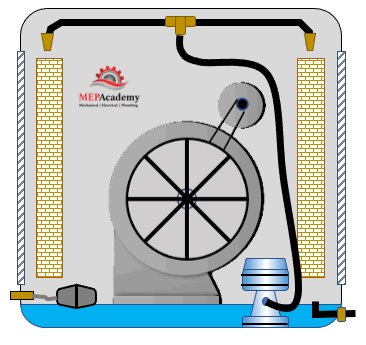
Roof Mounted Evaporative Cooler
We’ll explain a roof mounted system as it has more steps. After the system has been sized and selected, a hole would be cut in the pitched roof between roof supports for the supply air duct, making sure to seal tightly around the perimeter of the penetration with flashing to avoid leaks. The best location is on the backside of the home to avoid visibility from the front.
Next, you would use a crane or other method to safety hoist the evaporative cooler onto the roof positioned over the duct opening so that it lines up with the evaporative coolers bottom opening. Install support legs to add stability.
Evaporative Cooler Electrical
You will need to install a 120-volt electrical outlet near the unit and run wire inside to a wall switch or a controller. Check your local code as you may also forgo the electrical outlet and just run the electrical conduit and wire directly to the switch from the cooler. The controller will allow for low and high speeds, and for a fan only option. There may also be a pump only option that allows you to give time for the pads to absorb the water before sending hot air over them. Again, you’ll need to have a roof jack where the electrical conduit penetrates the roof. This will ensure that you can make a proper seal to avoid roof leaks.
Evaporative Cooler Water Tubing
A small residential system could use a 1/4” water tube. The tubing will need to be connected to an existing water pipe to provide the cooler with a continuous supply of water. The tubing can be installed in copper, PEX or plastic tubing, check your local code to make sure of the approved material types. It’s best to have one continuous length of tubing in the attic or in concealed spaces to avoid additional points where leaks could occur.
A shutoff valve should be provided at the point of connection to the main water supply to isolate the tubing if there is a leak, and at the evaporative cooler for quick access. In areas that experience freezing winters, it’s a good idea to provide a tee connection near the main water source with a drain valve to drain the tubing to avoid freezing, which could cause damage to the tubing.
Checkout these Evaporative Coolers hereThe tubing connects near the evaporative coolers float valve. This tubing will also need a roof jack to prevent roof leaks. There will also need to be a connection for the overflow drain connection as you don’t want unsightly water stains running down your roof.
Evaporative Cooler Ductwork
There are several options when installing the supply air duct. There is the option to have one large opening in a central location like the hallway, hopefully the evaporative cooler can be located directly above and make a simple straight duct drop.
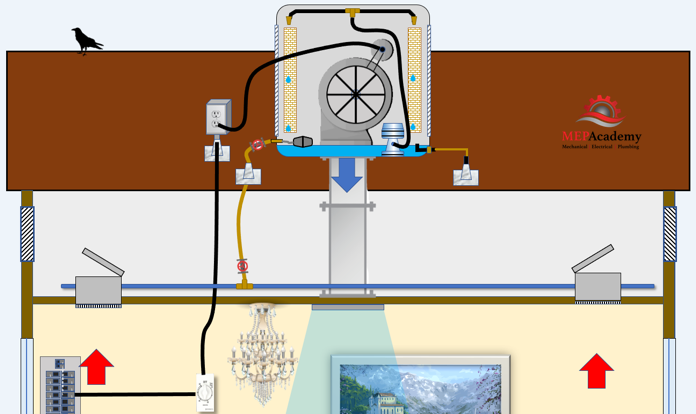
You could also duct the supply air to each room.
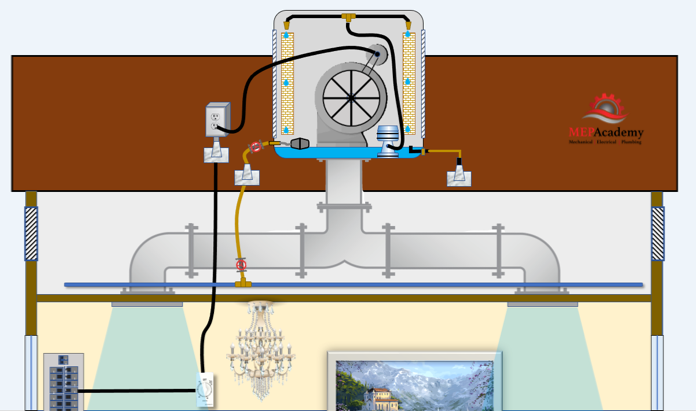
Frame out around the ceiling opening and install a supply grille. You should never use the existing air conditioning ducts as they aren’t sized for the air volume of an evaporative cooler.
Selecting an Evaporative Cooler
Evaporative coolers are rated by the volume of air that they can provide in cubic feet per minute (CFM). Manufactures recommend that a certain number of air changes be provided depending on the geographical location of the space. For an explanation on how to calculate Air Changes per Hour, see our video on “How to Calculate Air Changes per Hour”. The warmer the climate the greater the number of air changes that will be required.
Air changes could range from 20 to over 40 air changes per hour. For a 1,500 Ft2 home with 8-foot ceilings this would roughly be about 4,000 CFM at 20 Air Changes per hour, or 8,000 cfm at 40 Air changes per hour. Evaporative coolers use larger volumes of air than a traditional air conditioner, so the ductwork is larger to handle the greater CFM’s.
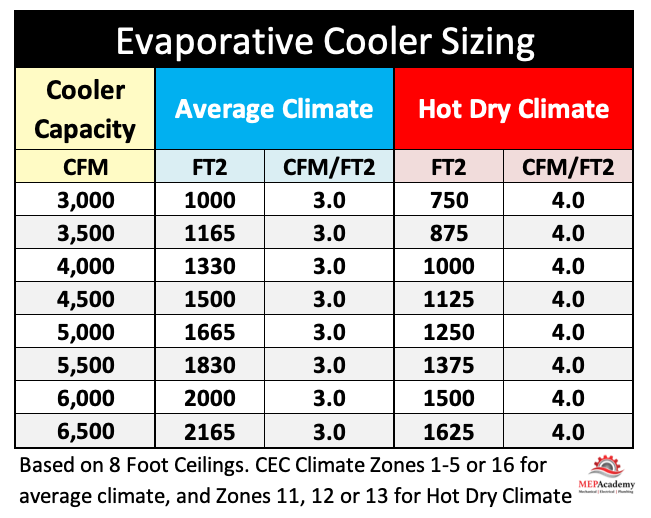
Pacific Gas and Electric (PG&E) has a chart for sizing Energy-Efficient Ducted Evaporative Coolers for properties located in hot, dry climates (such as California Energy Commission (CEC) climate zones 11, 12 or 13, the Central Valley) and if your home was 1,250 Ft2, this would require a 5,000 CFM unit. This equals 4 CFM/Ft2. These values are based on 8-foot ceilings.
You can see that in the zones with an Average Climate a design of 3 CFM/Ft2 was used, while a Hot dry Climate is designed using 4 CFM/Ft2
Consult with an evaporative cooler supplier for the correct size for your application.
Airflow Strategies
Do evaporative coolers need to be vented? Yes, there should be a path provided for the large volume of air that is coming into the building. The air must go somewhere, so its imperative that you control the path of air to achieve the cooling results you’re looking for.
There are several strategies for providing proper airflow within the building served by an evaporative cooler.
Vents can be provided in the ceiling that allow hot air to escape the rooms as the new cooler air enters. These ceiling vents would exhaust into the attic space, thereby requiring the attic to be vented.
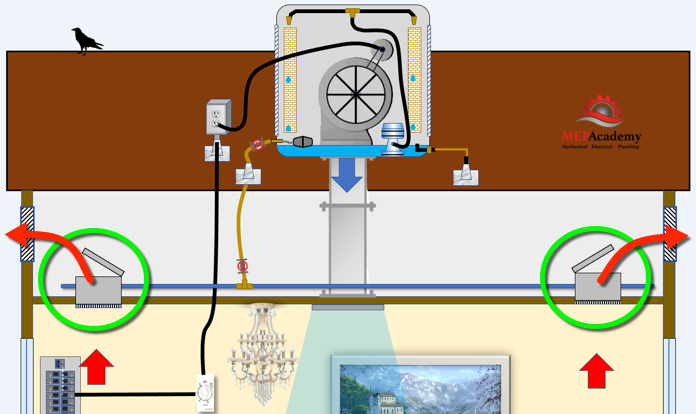
Venting into the attic also helps reduce attic temperatures which contributes to the overall objective of a cooler occupied space. Venting eliminates the security risk of having to leave the windows and doors open as used in the next strategy.
Leaving the windows slightly open allows the warmer air to escape the room as the evaporative cooler brings in 100% outdoor air. There is no recirculation of air through the system, as there is with an air conditioning system.
Checkout these Evaporative Coolers here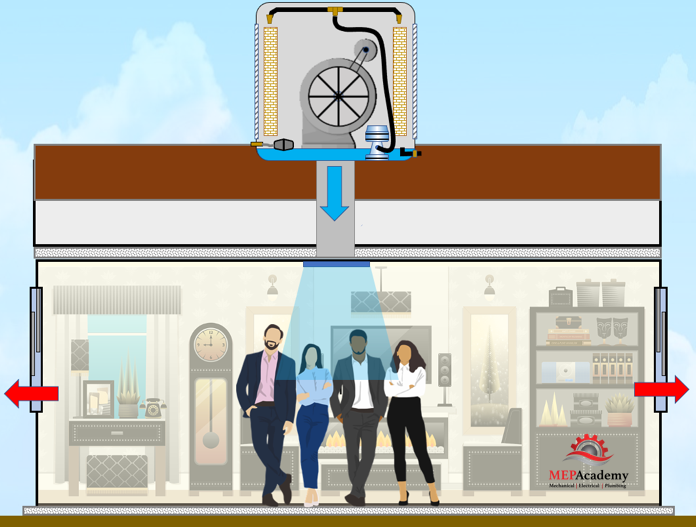
With evaporative cooling it’s important to allow warm air to escape. This will help remove the heat from the space and avoid excessive moisture from accumulating in the building. Traditional air conditioners recirculate the air within the space and work best with all windows closed and a tightly sealed structure.
To control the flow of air within a home, it is recommended to strategically open certain windows to direct air movement. Avoid opening windows on the windward side, to avoid additional hot air from entering the space. Cracking open the windows on the leeward side of the building will allow for the warm air to escape. Avoid opening them too wide as hot air will enter the space, while not opening them wide enough will cause moisture to buildup in the space. Experiment with various openings to see how the air flows, while keeping windows closed in unoccupied rooms.
How Evaporative Coolers Work
The pump that is sitting in the water reservoir pulls water in and then sprays it over the media pads located on the side panels of the cooler, while the fan draws in hot dry air over the wet pads. The pump keeps the pads wet as the warm air travels through them, causing water to evaporative.
When water evaporates and turns into a gas it cools the dry air entering the cooler. As water evaporates and the water level in the pan begins to drop, it will activate the float valve, which will allow water into the pan until the float valve shuts off the makeup water.
The controller can be used to increase the fan speed on hot days from low to high, and or on mild days to fan only. A thermostat can be used to automatically turn the cooler on when a certain temperature is reached within the space, or a manually operated controller could be used. The thermostat can also start the water pump before the fan to ensure the pads are wet before hot dry air is brought in over them.
Evaporative coolers usually allow for several fan speeds and a fan only option. It should allow the water pump to be shutoff and only the fan to run to circulate air. Without the pump running, no water will be sprayed over the pads and the air will not be humidified. This works in mild weather or at night when less cooling is required. The fan only option allows for its use like a whole-house fan.
The evaporative cooler uses water for cooling while the traditional air conditioner uses refrigerant.
Remember that heat moves from a warmer substance to a cooler one, so the warm air is cooled down while the water absorbs some of the air’s heat, causing some of the water to evaporate. This drives the dry bulb temperature of the incoming air down, while increasing the wet bulb temperature and humidity level of the air entering the room.
As the heat from the air is absorbed by the water the sensible temperature of the air is lowered while its latent heat content or moisture level is increased. This raises the relative humidity of the space as this air is directly ducted into the space to be cooled.
Each side of a roof mounted evaporative cooler should easily have removal side panels for ease of media replacement.
Checkout these Evaporative Coolers hereEvaporative Coolers vs Air Conditioning
Evaporative coolers are much less expensive to purchase and operate than the convention air conditioner, as there is no compressor or condenser fan. The evaporative cooler uses just a fan and small water circulating pump. Since water is the basis of the cooling effect, they work best in low humidity areas.
Evaporative coolers are used for temperature reduction and humidification. There are two basic configurations, direct and indirect evaporative cooling. With a direct evaporative cooler, the air comes in direct contact with the water, as opposed to the indirect evaporative cooler where the water and air stream don’t meet each other.
With evaporative coolers there is less energy consumed then a traditional air conditioner, as the evaporative cooler only has a pump and fan that consumes energy. There is the use of water that needs to be considered.
With the use of direct evaporative cooling the water meets the air provided to the space, giving the air a filtering effect. The washing of the air can remove dust, smoke, and particles from the air stream, much like a scrubber.
When using wetted surfaces or evaporative media pads, they should be made of materials that will prevent corrosion. The use of aluminum or stainless-steel helps prevent corrosion.
Where do Evaporative Cooler Work Best
Evaporative coolers work best in dry, low wet bulb, and low relative humidity areas, as the results of the cooling effect are the based on the difference between the dry bulb and wet bulb of the entering air. The dry bub temperature can’t be reduced lower than the wet bulb temperature, so this limits the amount of cooling.
When the dry bulb temperature reaches the wet bulb temperature, the air is totally saturated with moisture. In high humidity climates evaporative coolers don’t work as well because they use evaporation as the process for cooling. Evaporation works best in low humidity regions. High humidity regions should use traditional air conditioners.


